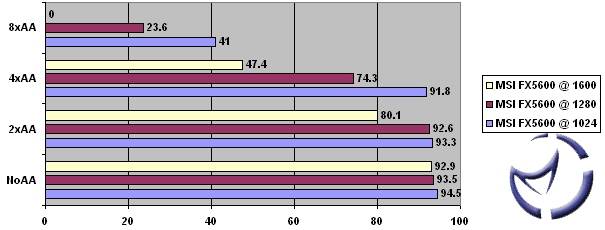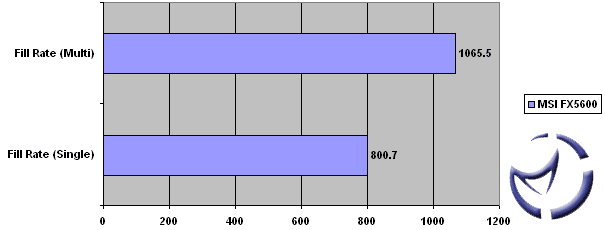UT 2003 Antelus Low Quality, No AA

UT 2003 Antelus Low Quality, 4xAA

We can see the GeForce FX5600 beating out the Ti4200 in every single run. The FX takes a huge lead when Anti-Aliasing is utilized, almost doubling the Ti4200's framerate (4xAA dm-antalus @ 1024x768) in some cases, while only 5 fps faster in others (4xAA ctf-citadel @ 1600x1200)
Next I ran the card through a rigorous amount of benchmarking.
I have decided to use the maps dm_antalus, dm_inferno, and ctf_citadel for evaluation in benchmarking.
UT 2003 HQ, No AA

With Anti-Aliasing disabled we see some pretty impressive scores. The high quality settings in UT2k3 are nothing to scoff at, and the 5600 has managed pretty well.
What about Anti-Aliasing?
UT 2003 HQ, 4xAA

With Anti-Aliasing enabled (Click here for all 2 sample, 4 sample, and 8 sample results) we can see the FPS drop from sample to sample. At 1024x768, we can see the jump from no Anti-Aliasing to 2 sample ends up being a drop of about 10 FPS. At 1280x1024 we see a drop of anywhere from 20 to 10 FPS, and the same for 1600x1200.
The same FPS drop is experienced from 2 sample to 4 sample Anti-Aliasing. Upon moving to 8 sample Anti-Aliasing there's a pretty significant drop, although it seems to be two times the drop experienced going from no Anti-Aliasing to 2 sample Anti-Aliasing; the card's Anti-Aliasing frame rates are pretty consistent overall in the UT2k3 testing.

Click to Enlarge
There seems to be an initial drop from no anti-aliasing to 2x anisotropic filtering, but after that, ramping anisotropic filtering up to 8 sample results in a very small drop in FPS.
UT 2003 HQ, 8xAA, 8xAF

Finally, I put this card through it's final UT2k3 torture test - 8 sample Anti-Aliasing and 8 sample Anisotropic filtering. This produces the lowest average fps score I could generate on the card: 8.6 FPS on dm_inferno, which is pretty damn good if you ask me.
Jedi Knight 2
Next, I ran Jedi Knight II for a real-world OpenGL test.

From 1024x768 to 1600x1200, the card manages to stay above 92 FPS.
You may be wondering what happened to the 8xAA score at 1600x1200. When I ran the jk2ffa demo at 1600x1200 I ended up getting approximately 47 FPS - just about double the frame rate that the card achieved at 1280x1024. After running the demo a few more times, and some image quality analyzation, I have concluded that the card did not run at 8xAA, but instead dropped down to 4xAA.
The only reason that I can fathom that the card dropped down from 8xAA to 4xAA was due to the fact that UT2k3 uses heavily compressed textures, and Jedi Knight II does not - I believe that the card ran out of RAM and therefore had to ignore the user-defined setting and go to the highest Anti-Aliasing setting that the RAM would allow for.
CodeCreatures
Next I used the CodeCreatures test at 1600x1200, 1280x1024, and 1024x768.

The CodeCreatures test was a bit disappointing, I had expected higher scores from the card - I suppose nVidia didn't care much to make sure their cards would perform well with intensive DX8 games.
SpecViewPerf7
SpecViewPerf7 is a synthetic benchmark designed for the professional work environment - CAD work, 3D modeling, and other real world OpenGL intensive professional jobs are tested in the benchmark.

The thing to keep in mind with this synthetic benchmark is simply that this isn't a Quadro video card, this card was not designed for maya and lightwave - it's designed for gaming. So these numbers won't necessarily reflect upon how well the card will do in a game, but it does reflect how well the card can render detailed, complex, and advanced scenes.
3D Mark 2003
Next are the 3Dmark2003 Benchmarks. I want to address those readers who are concerned with nVidia cheating with their drivers. This review is not the appropriate place for that discussion, however, feel free to discuss this in our forums under the appropriate thread. I will not be using 3DMark2003 summary for it's game benchmarks - only the Fill Rate and Vertex and Pixel Shader benchmarks will be utilized for benchmarking this card.
3D Mark 2003 Fill Rate in Mtexels/sec

3D Mark 2003 Vertex and Pixel




